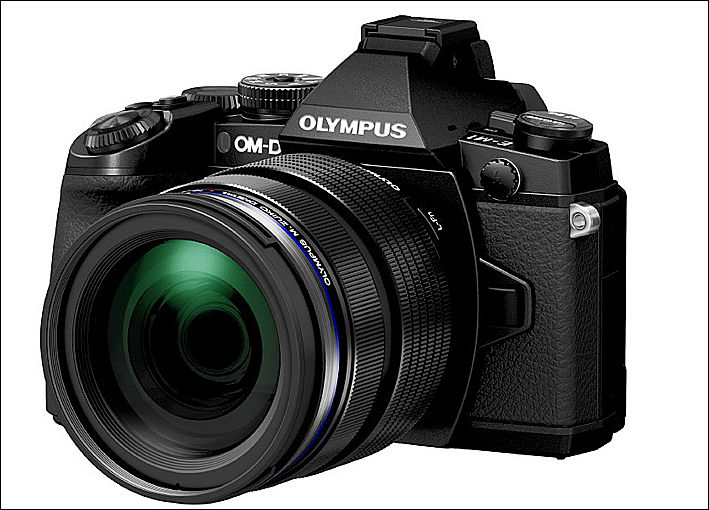
-

Specs:
•16MP MOS m43 sensor * No AA filter * True Pic VII processor, * Phase AF on sensor * 5-axis stab * 100-25600 ISO * 1/8000 sec shutter speed, 1/320 flash sync * 10fps shooting * 6.5fps with AF * Flash X-sync socket * 1.04mp 3" LCD * 2.36M EVF * Wi-Fi
Available at:
- http://www.amazon.com/Olympus-Compact-System-Camera-3-Inch/dp/B00EQ07PG2/
- http://www.amazon.com/gp/feature.html/ref=search_sparkle_EM1?ie=UTF8&docId=1001385991&pf_rd_m=ATVPDKIKX0DER
Previews:
- http://blog.mingthein.com/2013/09/10/olympus-om-d-e-m1-review-1/
- http://robinwong.blogspot.ru/2013/09/olympus-om-d-e-m1-review-introduction.html
- http://www.photographyblog.com/news/olympus_om_d_e_m1_hands_on_photos/
- http://www.thephoblographer.com/2013/09/10/first-impressions-olympus-omd-em1-3/
- http://www.adorama.com/ALC/BlogArticle.aspx?googleid=0014299&alias=Olympus-OM-D-E-M1-Hands-On
- http://www.tvsmith.my/new-olympus-om-d-em-1/
- http://www.pekkapotka.com/journal/2013/9/9/olympus-om-d-e-m1-hands-on-preview.html
- http://www.smallcamerabigpicture.com/om-d_e-m1/
- http://www.dpreview.com/previews/olympus-om-d-e-m1/
- http://www.imaging-resource.com/PRODS/olympus-e-m1/olympus-e-m1A.HTM
- http://www.popphoto.com/gear/2013/09/new-gear-olympus-om-d-e-m1-flagship-interchangeable-lens-camera
- http://www.pocket-lint.com/news/123113-hands-on-olympus-om-d-e-m1-review
- http://www.steves-digicams.com/camera-reviews/olympus/om-d-e-m1/olympus-om-d-e-m1-review.html
Press release:
Owners of full-format and APS-C DSLR cameras have a problem and Olympus has created a camera to solve it – the OM-D E-M1, the new pinnacle of Olympus’ digital imaging range. A DSLR is often too bulky to carry, which is why the new OM-D E-M1 is more compact than its main rivals – and the ideal size for shooting on the go. It combines the portable dimensions of the Micro Four Thirds format with image quality that matches DSLRs. Thanks to a new Live MOS sensor and next-generation TruePic VII image processor, it delivers the best images in the history of Olympus cameras. The E-M1 trumps the autofocus performance of its OM-D predecessor with DUAL FAST AF – one of the world’s fastest AF systems – now available for sequential as well as regular stills. It has an electronic viewfinder with the magnifying power of a high-end, full-frame DSLR and the unique* 5-axis image stabilization system that made its OM-D debut on the E-M5. The E-M1 is splash-, dust- and freezeproof** and – thanks to DUAL FAST AF – compatible with an ever-growing range of interchangeable lenses. It is available for pre-order in black with a special offer, and in the shops with an additional offer for E-System users from mid-October 2013. Prices start at £1299.99 for the body only, £1499.99 (UK prices) for the M.ZUIKO DIGITAL 12-50mm 1:3.5-6.3 lens kit and £1949.99 for a kit that includes the new M.ZUIKO DIGITAL 12-40mm 1:2.8 lens.
Olympus’ fastest ever AF: Alongside the design specialists who gave the OM-D E-M1 its perfectly proportioned casing, Olympus clearly employs some of the world’s best autofocus engineers. E-M1 owners reap the rewards with Olympus’ fastest ever AF system. DUAL FAST AF delivers very quick autofocus performance with both Micro Four Thirds and Four Thirds lenses, which can be mounted on the E-M1 using an adapter. The camera detects which sort of lens you are using and switches automatically to the more suitable AF technology – either phase detection or contrast AF. Four Thirds lenses work with phase detection, whereas Micro Four Thirds use Contrast AF. Both AF technologies can accurately focus on any one of 37 focus points to pick out, for example, a single stallion among stampeding horses, or on 81 target areas to automatically track the whole herd.
Olympus' best ever images: When a company with the optical pedigree of Olympus claims a new camera delivers the best image quality of any consumer model it has ever made, that device has a lot to live up to. The OM-D E-M1 more than matches expectations – and rebuffs DSLR sceptics – thanks not least to three key, complementary components. The Four Thirds and Micro Four Thirds lens system (63 lenses and growing) combines with a new 16-Megapixel Live MOS sensor and the seventh generation of its powerful TruePic image processor series. TruePic VII uses New Fine Detail Technology II to get the very best still image quality out of every lens by adjusting processing in line with the type of lens attached and aperture setting.
Olympus'most powerful electronic viewfinder: Olympus gives creativity free reign and breaks new ground in electronic viewfinder design in the shape of a new EVF with fully 1.48x magnification, which is approximately 1.3x larger than a typical DSLR. In addition to high, 2,360,000-dot resolution, DUAL FAST AF and automatic backlight adjustment, the EVF scores over optical viewfinders with a new feature that is unique to the OM-D E-M1. HDR Preview Mode allows you to monitor HDR images in the EVF before you shoot and you can likewise experiment with four key settings before shutter release: aspect ratio, magnification, colour and highlight & shadow. The OM-D E-M1 also introduces a new way to adjust colour. Instead of graphs and numbers, the newly developed Colour Creator lets you intuitively play with colour by tweaking dials on top of the camera. You can check the result in real time on the Live View EVF. The time lag is a mouth-watering 29ms, which is too fast for the human eye and results in natural movement even with very fast-moving subjects***.
Olympus' most reliable camera ever: Olympus’ record-breaking Hybrid 5-axis Image Stabilization is exceptional because it compensates for movement around the axis of the lens as well as horizontal and vertical shift, and the usual yaw and pitch. This makes it noticeably easier to capture sharp, hand-held stills, especially at large zoom ratios. In fact, the Hybrid IS is so effective that you can record a shake-free Full HD movie literally on the run – even with long focal lengths – easily framing shots with the viewfinder or LCD in real time. Just as reassuring is the E-M1’s rigid magnesium body, as well as its dustproofing**, splashproofing** and freezeproofing**, which protects your investment with another Olympus world-beating system. The OM-D E-M1 is the best camera guaranteed to work perfectly in temperatures as low as -10°C*.
Olympus’ smartest ever WiFi integration: Among the E-M1’s many other strengths are built-in WiFi, which lets it communicate quickly and simply with a compatible smartphone. You can send selected images straight to websites and social media via your phone and effectively use it as a remote control to avoid touching the camera during long-exposure shots. Pairing is quick and easy via a QR code. You can mirror the Live View LCD on your phone’s touch screen, then focus and release the shutter remotely via WiFi (in P, A, S, M modes) directly on the display. Even the unique and spectacular Live Bulb effect can be previewed on your smartphone. Live Bulb updates the Live View image at pre-set intervals during bulb exposures.
Olympus’ most pro-friendly system camera: The OM-D E-M1 was designed in close collaboration with pro photographers who gave Olympus a wish list of ways to make cameras more ergonomic. With an eye on the fate of unwieldy DSLRs, re-assignable dials, switches and rings are big and beautifully laid out to ensure the camera sits comfortably in your hand and is easy to use. For example, you can adjust aperture and exposure using two dials on the back, then flick a lever to change the function of the dials and adjust ISO and white balance with the same movement.
-
Fix to previous buggy firmware released
http://cs.olympus-imaging.jp/en/support/imsg/digicamera/download/software/firm/e1/#fmzdl
-
Firmware Ver.4.2
- Macro Flash STF-8 is supported.
- Electronic Flash FL-900R is supported.
- Improved stability of exposure when shooting videos.
- Focus stacking function is now supported by the following lenses:
- M.ZUIKO DIGITAL ED 30mm F3.5 Macro
- M.ZUIKO DIGITAL ED 7-14mm F2.8 PRO
- M.ZUIKO DIGITAL ED 8mm F1.8 Fisheye PRO
- M.ZUIKO DIGITAL ED 300mm F4.0 IS PRO
http://cs.olympus-imaging.jp/en/support/imsg/digicamera/download/software/firm/e1/#fmzdl
-
@johnbrawley Thanks so much for the lighting plots.
-
Again $799 deal, with used being $500
https://www.amazon.com/Olympus-Mirrorless-Digital-Camera-3-Inch/dp/B00EQ07PG2/
-

 img408.jpg656 x 437 - 34K
img408.jpg656 x 437 - 34K -
In case anyone was interested I did a little test and compared the video modes of the EM 1 to the E-M5 Mark II
https://johnbrawley.wordpress.com/2016/02/15/olympus-em1-for-video/
JB
-

 img209.jpg725 x 586 - 44K
img209.jpg725 x 586 - 44K -
Ver.4.1 firmware
- The stability of the image stabilizer's operations has been improved.
- The problem in which the external flash would not fire when shooting in RC mode has been corrected.
http://www.olympus.co.jp/en/support/imsg/digicamera/download/software/firm/e1/
-
V4 firmware released
-
v4 firmware overview

http://www.mirrorlessons.com/2015/11/03/olympus-firmware-update-4-0-focus-stacking/

 zebra295.jpg800 x 603 - 82K
zebra295.jpg800 x 603 - 82K -
I'm wondering whether new Firmware update of OLYMPUS OMDs with focus bracketing will work together with Auto-Blend Layers/Stack Images extension of ElementsXXL....
http://www.thepluginsite.com/products/elementsxxl/screenshots.htm#panel
-
Audio recording start trigger via USB with the LS-100 recorder is a nice feature. No more need for in-camera sync tracks and secondary microphones.
-
Firmware update v4.0 coming two cameras
http://www.olympus-global.com/en/news/2015b/nr150915omde.jsp
Focus Stacking Mode (OM-D E-M1 only)
Focus Stacking Mode let you shoot macro photos that are completely in focus at all depths. A single press of the shutter button captures 8 shots with different focal positions, automatically merging them into a single shot on the camera. Depth of field larger than that of minimum aperture and high resolution without diffraction can be achieved.
Focus Bracketing Mode
This function captures up to 999 shots with the focus position for each shot being changed, allowing you to use photo retouching software to merge the images with larger depth of field that cannot be achieved in focus stacking mode (8 shots).
S-OVF (Simulated OVF)
S-OVF enables a view that is similar to that of an optical viewfinder.
Exposure compensation and white balance are purposely not shown in S-OVF so that users who are comfortable with the optical viewfinder in DSLR cameras can use the camera in the exact same way.
Movie-Exclusive Picture Mode: Flat (OM-D E-M5 Mark II only)
Movie-Exclusive Picture Mode Flat provides beautiful post-editing or grading color by lowering the contrast to minimize highlight blowouts and loss of detail in shadows.
Synchronized PCM Audio Rec. with Movie Recording
Functions have been added for shooting movies when connecting Olympus Linear PCM Recorder LS-100 via USB cable. Slate Tone can be added to make it easier to synchronize the audio and image after recording is complete, and a function for synchronizing the start of audio recording with movie recording on the camera is also available.
Enhanced functions on Olympus Capture Version 1.1
You can customize the display of items on the Super Control Panel so that only the required functions are displayed, and you can change the layout for easier access of the most frequently used functions. Direct PC saving is also available and the transfer speed is made faster by saving images directly to a computer without recording to an SD card. Transfer speed is improved up to 4 times faster than before. Tether shooting capabilities are also expanded. Features such as Keystone Compensation are now available to operate via a computer by connecting the camera to a computer.
MF Clutch and Snapshot Focus Disable
You can change settings from the menu to disable MF Clutch and Snapshot Focus.
Latest firmware for M.Zuiko Pro and Premium lenses
Along with this latest firmware upgrade, latest firmware for the M.Zuiko Pro and Premium lenses will also be released. Aperture drive has been improved for smooth exposure control even when shooting movies in situations with sudden changes in brightness. It also supports for disabling the MF Clutch and Snapshot Focus.
-
Robin Wong Olympus EM5II worth a good look, many nice samples
high res, crops, IS samples, video etc etc
-
Firmware v3.0
February 5, 2015 The award-winning flagship Olympus OM-D E-M1, featuring 5-axis image stabilization, TruePic VII image processor and tethered shooting, is now more impressive than ever before. With the introduction of new firmware Version 3.0, the weather-resistant camera is now capable of an impressive maximum 9 fps in the C-AF sequential shooting mode when using a Four Thirds or Micro Four Thirds lens, improving the ability to capture moving subjects.
The newest firmware upgrade features an enhanced algorithm for phase-detection, raising the former C-AF sequential shooting speed of 6.5 fps to a maximum high speed of 9 fps. With this update, AF tracking performance is improved when using continuous-AF (C-AF) Sequential H mode. When set to C-AF, 37-point on-chip phase detection AF is used. Now, when capturing a quick-moving subject, photographers never need to miss the shot. A maximum 10 fps remains available when set to single-AF (S-AF) Sequential H mode.
The update also adds support for the latest Version 2.5 of the Olympus Image Share Android and iOS app. Users can now select Movie as a shooting mode, and record movies while viewing the Live View screen on a smartphone.
-
I have posted this elsewhere, so apologies, but will add here as was largely shot on the E-M1 with only a few of the wide shots on GH3 and GoPro.
-
@mat33 Yes, using Vivid mode can help. It's just prove that EM1 very different camera than EM5.
Howdy, Stranger!
It looks like you're new here. If you want to get involved, click one of these buttons!
Categories
- Topics List23,992
- Blog5,725
- General and News1,354
- Hacks and Patches1,153
- ↳ Top Settings33
- ↳ Beginners256
- ↳ Archives402
- ↳ Hacks News and Development56
- Cameras2,367
- ↳ Panasonic995
- ↳ Canon118
- ↳ Sony156
- ↳ Nikon96
- ↳ Pentax and Samsung70
- ↳ Olympus and Fujifilm101
- ↳ Compacts and Camcorders300
- ↳ Smartphones for video97
- ↳ Pro Video Cameras191
- ↳ BlackMagic and other raw cameras116
- Skill1,960
- ↳ Business and distribution66
- ↳ Preparation, scripts and legal38
- ↳ Art149
- ↳ Import, Convert, Exporting291
- ↳ Editors191
- ↳ Effects and stunts115
- ↳ Color grading197
- ↳ Sound and Music280
- ↳ Lighting96
- ↳ Software and storage tips266
- Gear5,420
- ↳ Filters, Adapters, Matte boxes344
- ↳ Lenses1,582
- ↳ Follow focus and gears93
- ↳ Sound499
- ↳ Lighting gear314
- ↳ Camera movement230
- ↳ Gimbals and copters302
- ↳ Rigs and related stuff273
- ↳ Power solutions83
- ↳ Monitors and viewfinders340
- ↳ Tripods and fluid heads139
- ↳ Storage286
- ↳ Computers and studio gear560
- ↳ VR and 3D248
- Showcase1,859
- Marketplace2,834
- Offtopic1,320
Tags in Topic
- olympus 121












